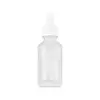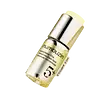What's inside
What's inside
 Key Ingredients
Key Ingredients

 Benefits
Benefits

 Ingredients Side-by-side
Ingredients Side-by-side

Water
Skin ConditioningMethyl Gluceth-20
HumectantNiacinamide
SmoothingButylene Glycol
Humectant1,2-Hexanediol
Skin ConditioningDipropylene Glycol
HumectantTranexamic Acid
AstringentArbutin
AntioxidantGlutathione
Cellulose Gum
Emulsion StabilisingDisodium EDTA
Glycyrrhiza Glabra Root Extract
BleachingSesamum Indicum Seed Extract
Skin ConditioningAngelica Gigas Root Extract
Skin ConditioningMorus Alba Bark Extract
Skin ConditioningPhellinus Linteus Extract
Skin ConditioningPaeonia Lactiflora Root Extract
Skin ConditioningPolygonum Multiflorum Root Extract
Skin ConditioningScutellaria Baicalensis Root Extract
AstringentCimicifuga Racemosa Root Extract
AntimicrobialSophora Flavescens Root Extract
AntioxidantWater, Methyl Gluceth-20, Niacinamide, Butylene Glycol, 1,2-Hexanediol, Dipropylene Glycol, Tranexamic Acid, Arbutin, Glutathione, Cellulose Gum, Disodium EDTA, Glycyrrhiza Glabra Root Extract, Sesamum Indicum Seed Extract, Angelica Gigas Root Extract, Morus Alba Bark Extract, Phellinus Linteus Extract, Paeonia Lactiflora Root Extract, Polygonum Multiflorum Root Extract, Scutellaria Baicalensis Root Extract, Cimicifuga Racemosa Root Extract, Sophora Flavescens Root Extract
Hippophae Rhamnoides Water
MaskingTranexamic Acid
AstringentTripropylene Glycol
AntioxidantGlutathione
Niacinamide
Smoothing1,2-Hexanediol
Skin ConditioningDiethoxyethyl Succinate
SolventHydroxyacetophenone
AntioxidantHydroxyethylcellulose
Emulsion StabilisingEthylhexylglycerin
Skin ConditioningDisodium EDTA
Ascorbic Acid
AntioxidantBisabolol
MaskingPanthenol
Skin ConditioningTocopherol
AntioxidantThioctic Acid
AntioxidantGlycerin
HumectantWater
Skin ConditioningCyanocobalamin
Skin ConditioningButylene Glycol
HumectantCaprylic/Capric Triglyceride
MaskingPolyglyceryl-3 Methylglucose Distearate
EmulsifyingHippophae Rhamnoides Water, Tranexamic Acid, Tripropylene Glycol, Glutathione, Niacinamide, 1,2-Hexanediol, Diethoxyethyl Succinate, Hydroxyacetophenone, Hydroxyethylcellulose, Ethylhexylglycerin, Disodium EDTA, Ascorbic Acid, Bisabolol, Panthenol, Tocopherol, Thioctic Acid, Glycerin, Water, Cyanocobalamin, Butylene Glycol, Caprylic/Capric Triglyceride, Polyglyceryl-3 Methylglucose Distearate
Ingredients Explained
These ingredients are found in both products.
Ingredients higher up in an ingredient list are typically present in a larger amount.
1,2-Hexanediol is a synthetic liquid and another multi-functional powerhouse.
It is a:
- Humectant, drawing moisture into the skin
- Emollient, helping to soften skin
- Solvent, dispersing and stabilizing formulas
- Preservative booster, enhancing the antimicrobial activity of other preservatives
Butylene Glycol (or BG) is used within cosmetic products for a few different reasons:
Overall, Butylene Glycol is a safe and well-rounded ingredient that works well with other ingredients.
Though this ingredient works well with most skin types, some people with sensitive skin may experience a reaction such as allergic rashes, closed comedones, or itchiness.
Learn more about Butylene GlycolDisodium EDTA plays a role in making products more stable by aiding other preservatives.
It is a chelating agent, meaning it neutralizes metal ions that may be found in a product.
Disodium EDTA is a salt of edetic acid and is found to be safe in cosmetic ingredients.
Learn more about Disodium EDTAGlutathione is an antioxidant naturally found in our bodies. It is made up of three amino acids: glycine, cysteine, and glutamic acid.
As an antioxidant, it prevents oxidative damage to parts of our cell.
While glutathione is said to help with fading dark spots, the results from research are inconclusive. Further studies are needed. With that said, gluthatione has been shown to protect our skin from UV-B induced damage.
This ingredient is naturally occurring in plants, animals, fungi, and some bacteria.
Learn more about GlutathioneNiacinamide is a multitasking form of vitamin B3 that strengthens the skin barrier, reduces pores and dark spots, regulates oil, and improves signs of aging.
And the best part? It's gentle and well-tolerated by most skin types, including sensitive and reactive skin.
You might have heard of "niacin flush", or the reddening of skin that causes itchiness. Niacinamide has not been found to cause this.
In very rare cases, some individuals may not be able to tolerate niacinamide at all or experience an allergic reaction to it.
If you are experiencing flaking, irritation, and dryness with this ingredient, be sure to double check all your products as this ingredient can be found in all categories of skincare.
When incorporating niacinamide into your routine, look out for concentration amounts. Typically, 5% niacinamide provides benefits such as fading dark spots. However, if you have sensitive skin, it is better to begin with a smaller concentration.
When you apply niacinamide to your skin, your body converts it into nicotinamide adenine dinucleotide (NAD). NAD is an essential coenzyme that is already found in your cells as "fuel" and powers countless biological processes.
In your skin, NAD helps repair cell damage, produce new healthy cells, support collagen production, strengthen the skin barrier, and fight environmental stressors (like UV and pollution).
Our natural NAD levels start to decline with age, leading to slower skin repair, visible aging, and a weaker skin barrier. By providing your skin niacinamide, you're recharging your skin's NAD levels. This leads to stronger, healthier, and younger looking skin.
Another name for vitamin B3 is nicotinamide. This vitamin is water-soluble and our bodies don't store it. We obtain Vitamin B3 from either food or skincare. Meat, fish, wheat, yeast, and leafy greens contain vitamin B3.
The type of niacinamide used in skincare is synthetically created.
Learn more about NiacinamideTranexamic Acid is best used for treating hyperpigmentation, discoloration, and melasma. It can also help build a stronger skin barrier.
Once applied, Tranexamic Acid starts decreasing inflammation from UV exposure. Tranexamic Acid also prevents our skin cells from meeting the pigment production cells.
Its brightening property makes it great at reducing the appearance of acne scars and marks.
Fun fact: Tranexamic Acid is also a medication used to reduce heavy bleeding.
This acid is derived from lysine, an amino acid.
Learn more about Tranexamic AcidWater. It's the most common cosmetic ingredient of all. You'll usually see it at the top of ingredient lists, meaning that it makes up the largest part of the product.
So why is it so popular? Water most often acts as a solvent - this means that it helps dissolve other ingredients into the formulation.
You'll also recognize water as that liquid we all need to stay alive. If you see this, drink a glass of water. Stay hydrated!
Learn more about Water